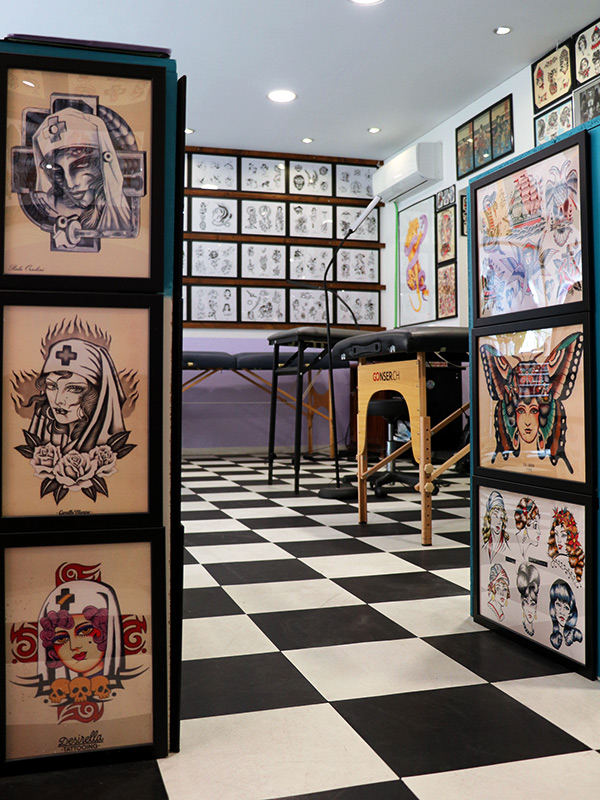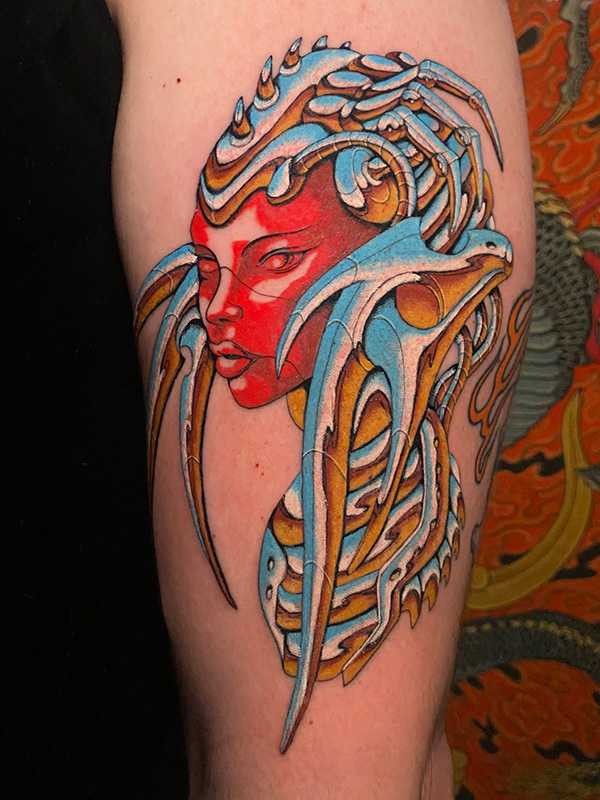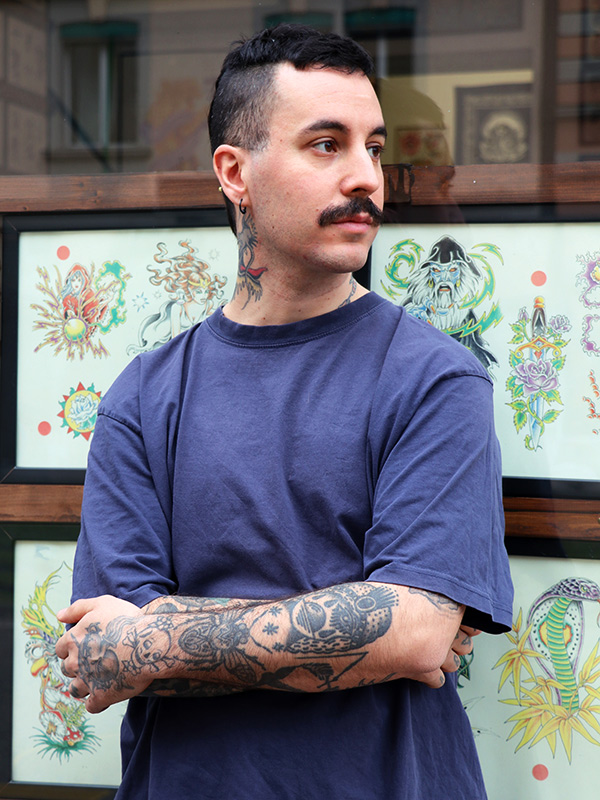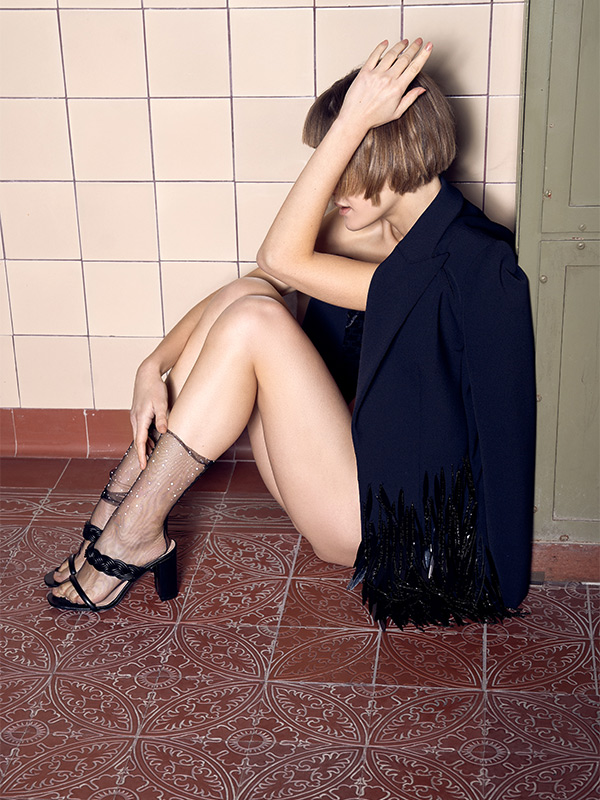Many want them, many have them – he makes them. As co-owner of the Love Street Tattoo Studio in Zurich, tattoo artist Giorgio de Duesanti is dedicated to one of the oldest forms of body art. In this interview, he reveals how it all came about and what he experienced along the way.
FACES: How did it actually come about that you became a tattoo artist?
Giorgio de Duesanti: I’ve always loved drawing and always thought tattooing was cool, so I bought a cheap tattoo machine set online and started tattooing myself. At the time, I was studying product design in Milan and working as a waiter on the side, and wasn’t actually thinking about becoming a professional tattoo artist. But then one day a man approached me when I was selling my artwork at a flea market and told me that he liked my drawings. He asked me if I would be interested in starting tattooing. At that time, I had already tattooed a few friends at home and I really liked it. So I went to his tattoo studio and about a week later I started tattooing there. After a few months, I knew that this was what I wanted to do for a living. But I realized that it wasn’t the right way to continue working in this store as I had no training. So I started looking for an apprenticeship. Eventually I got the chance to do an apprenticeship in Zurich and that’s how I ended up here.
FACES: How did your first date with the tattoo machine go?
Giorgio de Duesanti: Very bad. I tattooed myself and as I didn’t grow up in a tattoo environment, I didn’t really know anything about it. Neither my parents nor my friends had tattoos. I didn’t even know how to set up a tattoo machine properly – I eventually figured that out myself. Also, the spot I chose for my tattoo hurt a lot, so I didn’t get it deep enough. The tattoo looked really shitty.
FACES: “I want to be a tattoo artist” is a sentence that many parents don’t like to hear. How did your parents react?
Giorgio de Duesanti: When I decided to become a tattoo artist, I was about 24 years old and already living alone. So they were no longer really involved in my decisions. The fact that I wanted to make tattooing my profession was also not a decision that I made from one day to the next – it was a process. I finally decided to give up my studies and concentrate fully on tattooing. I didn’t tell them at first, but they realized it themselves after a while. Of course they were worried about me dropping out of university. But I was an adult, so there wasn’t much they could do. And about a year after I started my apprenticeship, I was already earning some money. So they saw that tattooing enabled me to get by on my own in another city. I think that was when they started to accept my decision. And now that I’ve been tattooing for eight years and have my own store, they are naturally very happy for me.
FACES: Do you think your parents were mainly concerned about your financial security?
Giorgio de Duesanti: Yes, I think so. Tattooing is an artistic profession and like most parents, they didn’t think it was a job that could give me financial stability. And they are not wrong. I could be out of a job tomorrow if I don’t make an effort to create new designs or win new customers. There is a lot of freedom in an artistic profession – nobody forces you to do your job. But that also means that you are responsible for keeping things running.
FACES: How did you imagine life as a tattoo artist and what is it actually like?
Giorgio de DuesantiI never imagined life as a tattoo artist, so I had no expectations – which is actually a good thing in my opinion. I became a tattoo artist because I enjoyed it, without making plans for the future. That’s a problem a lot of tattoo artists have when they start out these days. They see the big names on social media and think: “Oh, I want to be that successful one day”, whereas I never really had that expectation and was therefore able to focus on my work without any pressure.
FACES: What is the best thing about your job and what is the worst?
Giorgio de Duesanti: I would say the best thing about it is that I can travel a lot to work in different studios around the world. The tattoo industry is big, but the work is something that connects us. You always meet friends of friends, which creates a feeling of solidarity. The local tattoo artists also show me their country from their local perspective, so I really get to know the place, which I really enjoy. I never end up in a tourist trap.
The worst thing is probably the financial instability. Of course, you could advertise yourself as much as possible on social media, never turn down a request, good or bad. But I don’t believe in that. Because I impose this kind of restriction on myself, I may have fewer clients than I could have, and at the end of the day, this attitude to work leads to more instability. But I’d rather be able to keep looking at myself in the mirror and know that I can stand behind what I do.
“There is a lot of freedom in an artistic profession – nobody forces you to do your job. But that also means that you are responsible for keeping things running.”


FACES: What is the craziest thing that has happened to you in your tattooing career so far?
Giorgio de Duesanti: Tattooing at the Bay Area Tattoo Convention. It was one of the best tattoo conventions in the world and I tattooed alongside some of the biggest names in the industry. I had only been tattooing for about three years at that point, so it was a surreal experience for me.
FACES: What’s the weirdest request you‘ve received so far?
Giorgio de Duesanti: I don’t get many crazy requests. But when I was still an apprentice, a man came by one day who wanted a tattoo on his penis. Apparently he used to have a birthmark there, which he had to have removed, but now wanted to have it back. As I was still an apprentice, I didn’t have to do it. So another tattoo artist tattooed a dot where he used to have his birthmark.
FACES: Are there any motifs that you refuse to tattoo?
Giorgio de Duesanti: Yes, I don’t tattoo hate symbols, for example. Also, sometimes customers come to me and want a tattoo that just doesn’t work. If the lines of the desired design are too close together, for example, the tattoo will age badly. In such cases, it is my job as a tattoo artist to explain to people why the desired tattoo is not working and to find a solution to the problem.
FACES: What would you be if you weren’t a tattoo artist?
Giorgio de Duesanti: Maybe I would be a (not very happy) graphic designer.
FACES: How has the tattoo scene changed since you started out as a tattoo artist?
Giorgio de Duesanti: The industry hasn’t changed much. When I started, the big changes were already happening – Instagram was already a thing, for example.
FACES: Speaking of social media: how have Instagram and co. changed your industry?
Giorgio de Duesanti: It has made the art of tattooing more accessible to everyone. But the flip side is that there are now a lot more people trying to show their work on social media. Ultimately, being a tattoo artist these days is like being a small fish in a big ocean: even if it’s easier to show people what you do, it’s difficult to reach those people. Some tattoo artists promote themselves heavily on Instagram and the like to attract new customers. But I think if you only rely on social media to expand your clientele, it won’t work in the long run. Whether the algorithm picks up your content or not is subject to constant change. Where you used to be able to reach a lot of people with images alone, today the algorithm hardly pays any attention to you if you don’t post content that shows a face. And as tattoo artists who show tattoos and not faces, it can therefore be difficult to reach new customers via Instagram. So relying solely on a tool that can change every day is not a smart move in my opinion.
FACES: Do you feel that as a tattoo artist you have to be on Instagram these days?
Giorgio de Duesanti: It depends. If you’ve been tattooing for over 40 years and have already made a name for yourself, have a large customer base and so on, then you don’t need it. But if you’ve just started out as a tattoo artist, it will be difficult without Instagram. Nowadays it serves as a portfolio. For example, if you want to travel abroad to work in another studio for a while, they will look at you funny if you try to send your stuff by email. In addition, most customers nowadays contact us via Instagram to make an appointment.
“Even if it’s easier to show people what you do, it’s difficult to reach these people.”
FACES: What’s the biggest mistake people make when getting their first tattoo?
Giorgio de Duesanti: Incorrect placement of the design and problematic designs are the most common mistakes people make when getting their first tattoo. I’ll give an example of both: Let’s say someone decides to get a small flower tattoo and chooses the thigh as the location for the tattoo. The thigh is the perfect place for larger motifs. So if you get your first small tattoo there, you are using a place where you might want to get a large tattoo later on. With the little flower there, the tattoo artist either has to find a way to tattoo around it or cover it up – both of which make tattooing unnecessarily complicated. And a good example of problematic designs are designs where the lines are too close together. As I mentioned before, tattoos like this age badly over time and you end up with something that looks more like a dark patch. In such cases, I think it is the tattoo artist’s job to inform his clients about the problems with the desired design. But not all tattoo artists do this, which is why it is really important to choose the right tattoo artist.
FACES: What is the most important lesson you have learned as a tattoo artist so far?
Giorgio de Duesanti: If something is wrong with the tattoo, for example if the ink doesn’t penetrate properly, it’s most likely not because the ink is bad or the tattoo machine isn’t working properly, but because the skin isn’t stretched enough. So change the position of the body part to be tattooed and the problem is solved. If no one tells you, it’s hard to find out for yourself.
FACES: You also train apprentices. What do you want to give them as prospective tattoo artists?
Giorgio de Duesanti: Drawing for a tattoo and simply drawing are two different things. Because you have to consider many different aspects when you draw something that is to become a tattoo: The black has to be balanced, you have to think about the space between the lines and so on. When creating a design, you should always bear in mind that you are drawing for a tattoo.
FACES: Welchen Tattoo-Trend würdest du eliminieren, wenn du könntest?
Giorgio de Duesanti: Minimalism – in my opinion, that shows a lack of commitment.
FACES: Is there a motif that you would like to tattoo but have never had the opportunity to do so?
Giorgio de Duesanti: I would love to make a complete biomech bodysuit.
FACES: And who would you like to tattoo?
Giorgio de Duesanti: I have tattooed a few celebrities in Italy. And it wasn’t really a pleasure to work with them, because in my experience most of them are snobby. Of course there have been a few exceptions, but I’m not really interested in tattooing anyone famous.
FACES: As a tattoo artist, you travel a lot. Where is your favorite place to be?
Giorgio de Duesanti: My favorite place to be is the Love Street Tattoo Studio.
FACES: Suppose someone has one of your tattoos removed. Would you take that personally?
Giorgio de Duesanti: No, because it’s her tattoo. Especially the first few I did weren’t very good, so I could understand it.
“Drawing for a tattoo and just drawing are two different things.”
FACES: What do you think of tattoo artists who don’t have tattoos themselves?
Giorgio de Duesanti: You should get yourself a few. When I decided to become a tattoo artist, some of the first tattoos I got were on my hand and neck. It was like a promise to myself. I decided to make tattooing my profession, and having such visible body parts tattooed, in a way, sealed that decision. With tattoos in these places, it would be difficult to be hired in most professions. So from then on, tattooing was my only choice, so to speak. And getting a tattoo is also an important part of learning how to tattoo: You realize how it feels to be tattooed. You can watch someone tattooing up close and so on.
FACES: Which cliché about tattooed people annoys you the most?
Giorgio de Duesanti: None, because I honestly don’t give a shit what other people think.
FACES: Which are the best and which are the worst customers?
Giorgio de Duesanti: I would say that the best customers are those who like what you do and are open to suggestions. And the worst customers are the ones who like what you do – that is, they like your style – but then ask you for something else anyway.
FACES: As a tattoo artist, you always have to be highly concentrated at work. How do you relax after a long day in the studio?
Giorgio de Duesanti: To be honest, I have to concentrate more when I’m working on the design, i.e. when I’m researching and drawing, than when I’m doing the tattoo itself. For me, tattooing is the most relaxing part.
FACES: What is on your bucket list when it comes to your career as a tattoo artist?
Giorgio de Duesanti: I would love to organize a good tattoo convention.
FACES: What do you hope for the tattoo industry?
Giorgio de Duesanti: I hope that the industry will be less dependent on social media.

Giorgio de Duesanti
Are you doing what you really want to do with your life? The then 24-year-old Giorgio de Duesanti asks himself this question – and quickly realizes that the answer is actually no. So he turns his back on university and devotes himself to his true passion – tattooing. An apprenticeship in a tattoo studio takes the Italian to Switzerland. Eight years have passed since then. Now, as co-owner of Zurich’s Love Street Tattoo Studio, Giorgio is shaking up the scene and proving that jumping in at the deep end is always worthwhile.
@giorgiodeduesanti_lst @lovestreettattoo
Fancy a tattoo? Our tattoo guide will tell you everything you need to know. And so you don’t get any stupid ideas: Here are 112 bad tattoos.
Lead photos: © Adrienne Meyer







